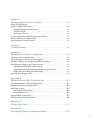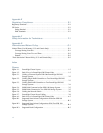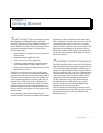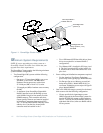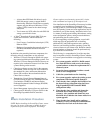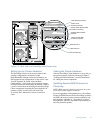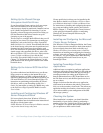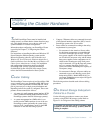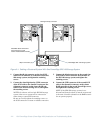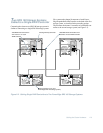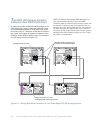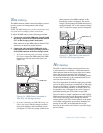
1-4 Dell PowerEdge Cluster (PowerEdge 4200) Installation and Troubleshooting Guide
8. Configure the public and private NIC intercon-
nects in each node and place the interconnects on
separate IP subnetworks.
9. If not already done, install and/or configure the
Microsoft Cluster Server software on each cluster
node.
10. Check out the functionality of the fully installed
cluster.
11. Install and set up applications.
The following sections briefly describe each of these
steps.
Adding Peripherals Required for
Clustering
NOTE: Hardware installation should be performed only
by trained service technicians.
If you are upgrading your existing hardware to a cluster
configuration, additional peripheral devices and expan-
sion cards need to be added to the system to meet the
minimum cluster requirements listed earlier in this
chapter.
For example, you need to install a second NIC card to
ensure that the system meets the minimum configuration
of two NIC cards—one card in PCI slot 8 for the public
LAN connection and another card in PCI slot 4 for the
node-to-node interconnection. You also need to add a
cluster-enabled PowerEdge Expandable RAID Controller
for the required shared storage subsystem used by the two
nodes.
NOTE: The first cluster-enabled PowerEdge Expandable
RAID Controller must be installed in PCI slot 7.
Figure 1-2 shows the placement of these devices in a
PowerEdge 4200 system. See Appendix A for further
information about upgrading an existing PowerEdge 4200
system with expansion cards required for clustering.
Additionally, you may need to add hard-disk drives and
another PowerEdge Expandable RAID Controller to the
PowerEdge system if you are configuring the system’s
internal drives as a RAID array. However, this is not a
requirement for clustering. Refer to the Dell PowerEdge
4200 Systems Installation and Troubleshooting Guide for
instructions on installing expansion cards or hard-disk
drives in the PowerEdge 4200 system.
If you are upgrading an existing SDS 100 storage system
to meet the cluster requirements for the shared storage
subsystem, you may need to install additional hard-disk
drives to the shared storage subsystem. The size and
number of drives you add depend on the RAID level you
want to use and the number of hard-disk drives already
present in your system. For information on installing
hard-disk drives in the PowerEdge SDS 100 storage sys-
tem, refer to the Dell PowerEdge SDS 100 Storage
System Installation and Service Guide.




